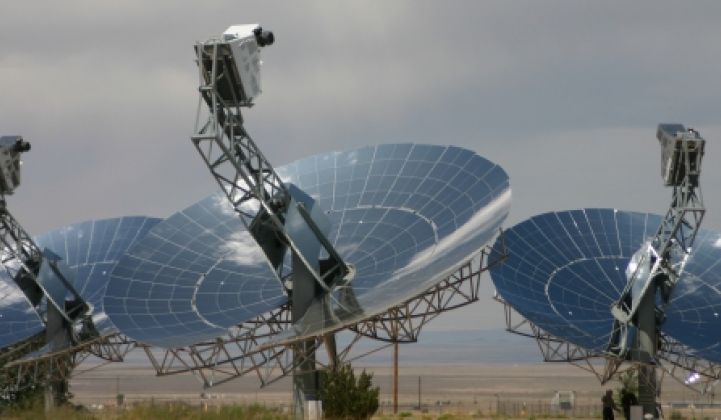Back in 2005, Stirling Energy Systems (SES) made news by agreeing to sell electricity to Southern California Edison and San Diego Gas & Electric. The deals would require the company to build up to 1.75 gigawatts of solar farms in the California desert.
The company had developed a prototype system, but needed more money to continue the projects. That financial support materialized in 2008, when the company announced in April that it had sold a controlling stake to Irish firm NTR for $100 million.
The money allowed SES to quicken its development pace and carry out the necessary re-engineering of its first-generation system in order to make it easy to manufacture and maintain, said Sean Gallagher, vice president of marketing and regulatory affairs for SES, in a recent interview. Gallagher also holds the same role at Houston-based Tessera Solar, which SES created to focus on power plant development.
The Scottsdale, Ariz.-based company says it has accomplish that goal and now plans to set up a 1.5-megawatt demonstration project near its headquarters later this year to show off its technology to investors and customers, Gallagher said.
"It's like kicking the tires," Gallagher said, adding that the credit crunch has made a demo project more critical than before to win financial support. "We think that the lenders and investors are going to want to see more of a slice of a system operating and some data before they are willing to finance larger projects."
SES calls its system SunCatcher, which is made up of a giant parabolic dish of mirrors (40 feet across) to concentrate the sun onto a receiver called a "power conversion unit (PCU)." Sunlight heats up the hydrogen gas in tubes in the PCU, and the gas goes through a heat exchanger to run a four-cylinder Stirling engine. The engine then drives a generator to produce electricity.
The history of Stirling engines goes back to 1816, when Robert Stirling in Scotland designed the first machine and built it two years later to pump water from a quarry.
Each 25-kilowatt SunCatcher is its own mini electricity-generating unit. SES would wire together 60 of them into a 1.5-megawatt group, Gallagher said. More wiring would then be done to create a cluster with 9 megawatts in generation capacity.
This setup would allow SES to start delivering power when the first 9 megawatts are installed, Gallagher said.
With the redesign, SES slashed the number of system components by more than half, Gallagher said. The components can be assembled in a way that would make them easy to get to for repair. SES also changed the parabolic dish from a rectangular shape to round and cut the amount of steel needed by 5,000 pounds, Gallagher said.
The company installed four new SunCatchers at Sandia National Laboratories nearly two months ago, and is holding an open house today at Sandia. It had previously set up six, older SunCatchers at Sandia, with which SES collaborates on technology development.
Stirling engine systems doesn't need any water for cooling, unlike other solar thermal technologies, said Nathaniel Bullard, an analyst with New Energy Finance. The systems do use water for cleaning the mirrors. The low water-use makes the Stirling technology a good option for desert installations, Bullard added. Many solar thermal power plants under development are taking place in the American southwest, where water is a precious commodity.
Whether SES would succeed in completing the projects would depend partly on its ability to manage the manufacturing and supply of the various components, Bullard said.
"You have manufactuer tens of thousands of standardized units. This is something PV industry has mastered some time ago," Bullard said.
SES, for its part, plans to hire auto parts makers to produce the components and assemble most of them in factories. The final assembly of each system would take place on the project sites, Gallagher said.
SES initially had planned to start building the project for San Diego by the end of this year. The 750-megawatt project, called Solar Two, would be located in Imperial Valley, about 100 miles east of San Diego. The project's size was initially set for 900 megawatts, but SES shrunk it to avoid encountering environmental issues.
It's the farthest along in the permitting process and requires approval from the federal Bureau of Land Management and the California Energy Commission. SES hopes to get the permits by late spring next year and start construction shortly after, Gallagher said. The plan is to start delivering power by December 2010 or January 2011.
SES's other project, the 850-megawatt Solar One, would be built on BLM land that is about 37 miles east of Barstow, Calif., close to a substation of Edison's transmission network.
SES plans to apply for loan guarantees from the U.S. Department of Energy to help finance both projects. Gallagher declined to say how much.
The company expects to get $54 million from NTR this year for development and corporate expenses, Gallagher added.
Aside from the two projects in California, SES also is set to provide SunCatchers to a new project being developed by Tessera. Tessera announced Monday that it would build a 27-megawatt solar farm in west Texas and sell the electricity to CPS Energy via a 20-year agreement. The project would make use of 1,080 SunCatchers.
Tessera plans to start construction next summer and start delivering power by the end of 2010. CPS is run by the city of San Antonio.
Join experts and influencers at Greentech Media's Growth Opportunities in the New PV Market: Projects, Finance and Policy in San Francisco on July 13.




